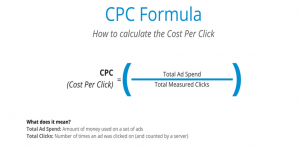In today’s digital age, advertising has evolved far beyond the realms of print and television. With the internet dominating the landscape, businesses have an array of options when it comes to promoting their products or services online. Because the pricing model will directly affect publishers’ revenue stream, understanding it helps them to have deeper insight on how to optimize their ad inventory to maximum potential. In the following paragraphs, we are going to dive into three most popular pricing models that are being used by most advertisers in today’s ad activities: CPC, CPM, CPA. It’s going to be a very long article so get ready!
Contents
What is CPM?
The CPM pricing model refers to the cost per 1,000 impressions; the word mille is Latin for one thousand.
Impression refers to the display of an advertisement on a web page or within an app. It represents the number of times an ad is viewed by users, regardless of whether they interact with it or not. The formula for CPM is:
![]()
For example, if an ads costs $10 and show 2000 times, the CPM will be:
CPM = (10/2000) x 1000 = 5$
When is CPM best used?
CPM (Cost Per Mille) is best used by publishers in various scenarios where maximizing ad impressions and overall revenue is a priority. The suitable scenarios for publishers to use CPM are when their sites or apps attract a large volume of traffic, consist of premium content or niche content with high engagement rates, ad placements that exhibit high viewability rates such as interstitial ads or rewarded ads.
CPM allows publishers to retain control over ad placement and frequency, as they are paid based on the number of impressions served rather than user interactions. Publishers can strategically place ads within their content to maximize visibility and engagement without the pressure of optimizing for clicks or actions.
Advantages and Disadvantages of CPM
Pros
- Steady Revenue Stream: Publishers receive payment based on ad impressions, providing a steady income stream regardless of user engagement.
- Suitable for High-Traffic Sites: Websites with high traffic volumes can benefit from CPM pricing, as even a small CPM rate can translate into significant revenue.
- Brand Awareness: CPM campaigns can help advertisers increase brand visibility by exposing their ads to a large audience.
Cons:
- Limited Revenue from Low-Engagement Ads: Publishers may earn less from ads with low engagement, as revenue is based on impressions rather than clicks.
- Ad Blocking Impact: Ad blockers can reduce the number of ad impressions, directly affecting CPM revenue for publishers.
- Quality Concerns: Publishers may face pressure to prioritize quantity over quality to maximize impressions, potentially compromising user experience.
What is CPC?
CPC or Cost-per–click is a pricing model used in online advertising where advertisers pay a certain amount each time their ad is clicked on by a user.
The formula for CPC is:

For example, an advertiser spend $5 for the ad campaign and receive 4 clicks from users, the CPC for that campaign will be:
CPC = $5/4 = $1.25
When is CPC best used?
CPC (Cost Per Click) is best used by publishers in several scenarios where they aim to monetize their website traffic effectively while providing value to advertisers. There many suitable situations for publishers to use CPC is when they have high-engagement content such as product reviews, how-to-guides, games with rewards or new articles. High quality traffic sources also affect advertisers’ willingness to bid higher CPC rates, as it has great potential of increasing CTR and their lead generation. Moreover, publishers that have flexible ad placement can attract higher CPC rates from advertisers, because it allows them to strategically position ads within their content to maximize click-through rates. For example, publishers who uses PubPower Sticky 4K has
Advantages and Disadvantages of CPC
Pros:
- Measurable Results: Since advertisers only pay for clicks, it’s easy to measure the ROI of CPC campaigns.
- Control: Advertisers have control over their budget and can adjust bids in real-time based on performance.
- Direct Response: Ideal for driving traffic to a website, generating leads, or making sales.
Cons:
- Competition: Popular keywords can be expensive due to high competition.
- Click Fraud: There’s a risk of fraudulent clicks, although ad platforms often have mechanisms in place to combat this.
What is CPA?
CPA, also known as Cost Per Action or Cost Per Conversion, is a pricing model where advertisers pay publishers only when a specific action is completed, such as a purchase, sign-up, or form submission. This model is highly performance-oriented and is often used in affiliate marketing and lead generation campaigns.
The formula for CPA is:
![]()
For example, if you spend $1,000 advertising the trial, and 200 people sign up, your CPA is:
CPA = $1000 / 200 = $5
When is CPA best used?
Cost Per Acquisition (CPA) can be particularly advantageous for publishers in certain scenarios where the primary objective is to drive specific actions from users, such as purchases, sign-ups, or form submissions. The suitable scenarios for publishers to use CPA are when their sites or apps have niche audiences, high-quality content that engages users and drives them to take action, or operate in e-commerce or affiliate marketing spaces.
Pros:
- Highly Targeted: CPA campaigns focus on driving specific actions, ensuring advertisers pay only for desired outcomes.
- Revenue Maximization: Publishers can earn higher commissions for valuable actions, such as sales or qualified leads, leading to potentially higher earnings.
- Risk Mitigation: With CPA, publishers bear less risk compared to other models, as they are paid only when desired actions are achieved.
Cons:
- Conversion Challenges: Generating conversions can be more challenging than clicks or impressions, requiring publishers to carefully select and optimize their traffic sources.
- Longer Sales Cycle: If the desired action involves a purchase or subscription, the sales cycle may be longer, delaying payment for publishers.
- Dependency on Advertiser Performance: Publishers’ revenue is tied to advertisers’ ability to convert leads into customers, making them vulnerable to fluctuations in advertiser performance.
What is eCPM?
eCPM stands for “effective cost per mille” or “effective cost per thousand impressions.” It is a metric used in digital advertising to calculate the estimated revenue generated per 1,000 impressions, regardless of the pricing model used (CPC, CPM, CPA).
The formula to calculate eCPM is:
![]()
Where:
- Total ad spend: The total revenue earned by the publisher from the advertising campaign.
- Total Measured Impressions: The total number of ad impressions served during the campaign.
eCPM provides a standardized way to compare the revenue performance of different advertising campaigns, regardless of the pricing model. It helps publishers evaluate the effectiveness of their ad inventory and make informed decisions about optimizing revenue.
For example, if a publisher earns $500 from 100,000 ad impressions, the eCPM would be calculated as follows:
eCPM = $500 / 100,000 x 1000 = $5
This means that the publisher is earning an average of $5 for every 1,000 impressions served.
In summary
Choosing the right pricing model is essential for publishers to maximize revenue while maintaining a positive user experience. CPC, CPM, and CPA each offer unique advantages and challenges, and the most suitable model depends on factors such as audience demographics, content type, and advertiser objectives. By understanding these pricing models and their implications, publishers can make informed decisions to optimize their advertising revenue streams effectively.
Increase CPM, CPA, and CPC rate with PubPower
PubPower helps publishers connect with over 30 SSPs and increase their revenue up to 250%. We offer publishers a one way ticket to their financial success with the high profit share model of 85% from their revenue. Moreover, PubPower platform also gives publishers a ground full of powerful tools including header bidding program, ad adjustment, Adblock Removal Tool that will help them to rocket their ad fill-rate.
The most noteworthy of PubPower features is the rewarded ads, an ad format known for attracting high CPM rates between $1,5 – $30. If you have any issues or questions, the PubPower support team will be available 24/7 at the Publisher Support Center to solve it all. Sign up for PubPower and start monetizing your content right now!




